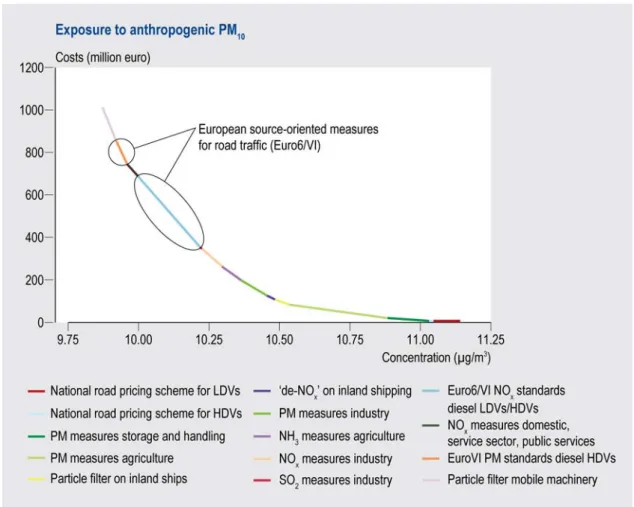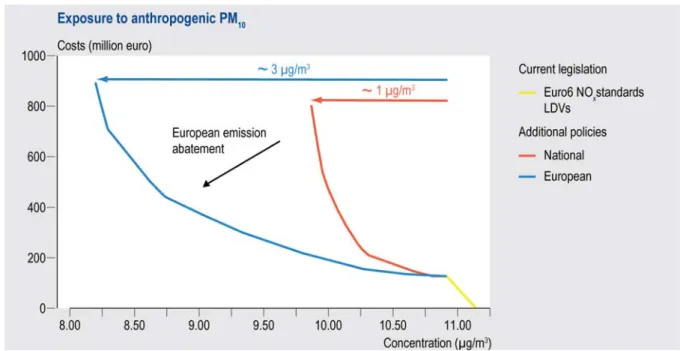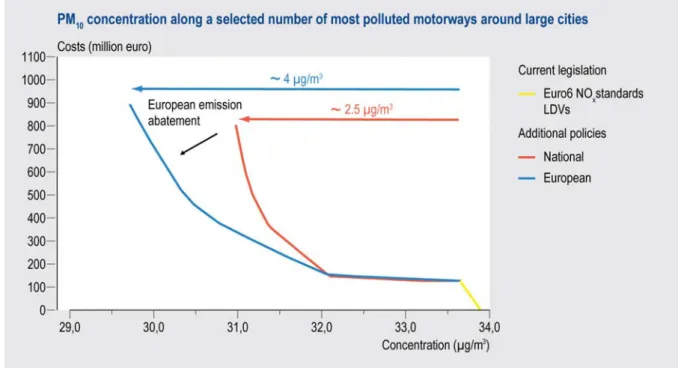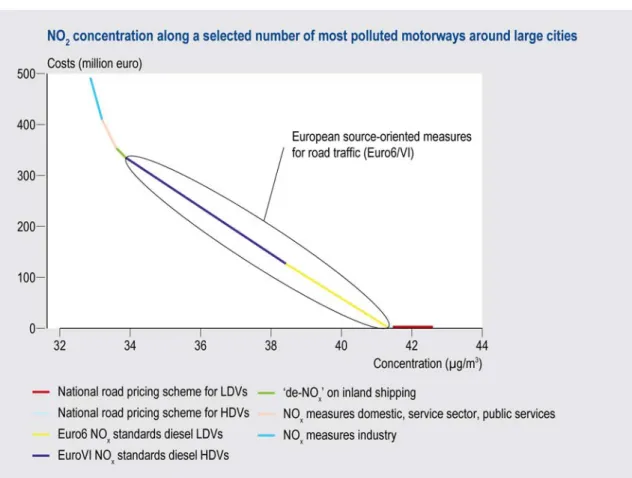Cost effectiveness of additional abatement options for cleaner air
Executive summary
W.L.M. Smeets, W.F. Blom, A. Hoen, B.A. Jimmink, R.B.A. Koelemeijer, J.A.H.W. Peters, R. Thomas, W.J. de Vries Contact:
Winand Smeets
European Air Quality and Sustainability Winand.Smeets@mnp.nl
This study was conducted by order of the Director of the Netherlands Environmental Assessment Agency, as part of project number M/500091: Cost effectiveness of European and National Air Pollution Policy
This executive summary is based on the Dutch-language report ‘Kosteneffectiviteit van aanvullende maatregelen voor een schonere lucht’, MNP report 500091001, August 2007.
Executive summary
More stringent national and/or European emissions policy is required to improve air quality in the Netherlands and to realize the legally binding European targets and deadlines for reducing emissions and improving air quality. To this end, the present report explores the cost effectiveness of possible supplementary national and European measures for cleaner air in the year 2020. This concerns abatement options that go beyond existing policy. Due to the
various policy objectives for air pollution, there are also various ways to describe the cost effectiveness of supplementary measures. Cost effectiveness is usually described in terms of emission reductions. In the present study, the cost effectiveness of measures has been calculated for following endpoints:
Reducing national emissions to comply with existing and more stringent indicative European emission ceilings.
Reducing the exposure of the Dutch population to particulate matter (PM10) in view of its relationship with premature mortality and general health problems.
Reducing the concentrations of particulate matter (PM10) and nitrogen dioxide (NO2) near motorways in view of current exceedances in the Netherlands of the European limit values for these components.
First and foremost, this report evaluates the cost effectiveness of supplementary measures in achieving the policy objectives listed above. Measures are ranked according to their cost effectiveness for each of the three endpoints. Also, the cost effectiveness of new community emission legislation for road vehicles (EuroVI/6) is compared with the cost effectiveness of measures in other sectors that may be implemented nationally. Secondly, this study
compares the effectiveness of a more stringent European emission reduction policy with that of a strictly national approach. This part of the study addresses the following questions. To what extent does the Netherlands depend on a more far-reaching European policy for the improvement of its own air quality? Formulated the other way around, to what extent can environmental progress be achieved by taking additional measures only in the Netherlands? Two policy variants at both extremes are considered. With the policy variant ‘national emissions policy’ it is assumed that the Netherlands alone takes supplementary measures, while the remainder of Europe takes no supplementary measures. With the variant ‘European emissions policy’ it is assumed that other EU countries also take far-reaching measures, with positive transboundary effects for the air quality in the Netherlands.
The calculations in this study were conducted for the year 2020. The point of departure for the analysis of additional measures is a ‘no policy change’ baseline scenario reported by the Netherlands Environmental Assessment Agency in 2006. This baseline scenario indicates the development of emissions and air quality, while the future implementation of existing
national and European policies into account. Such policies concerns measures such as the approved Euro5 emission standards for passenger cars and light delivery vehicles, the approved control measures from the 2005 air quality programme of the Dutch government (Prinsjesdagpakket) focusing on road traffic, and the recently agreed Dutch SO2 measures applying to the refineries and energy sector.
The present study focuses on the technical possibilities for an air quality policy that goes even further than the above measures. Measures that have been evaluated in this report are
the implementation of more stringent European emission standards for light and heavy duty vehicles (EuroVI/6), and additional measures applying to other sectors such as inland shipping, mobile machinery, agriculture, industry and storage and handling companies. The only non-technical measure that was studied was the introduction of a national road pricing scheme for light and heavy duty road vehicles. For passenger cars and light delivery vehicles, this concerns a national road pricing scheme differentiated according to time and place, in accordance with the final proposal from the Mobility Memorandum (Nota Mobiliteit). For trucks, this concerns a road pricing scheme that is differentiated according to Euroclass, in accordance with the options document on traffic emissions (optiedocument verkeersemissies). Local measures such as speed limits, establishing environmental zones, traffic management measures, parking policies, placing protective barriers along motorways and covering over motorways were not considered in our report. National and international studies have shown that such local measures can also be cost effective for improving air quality along motorways and in busy streets.
The cost effectiveness of measures is an important selection criterion when making political decisions, but it is certainly not the only criterion. During political decision-making about appropriate measures, many other aspects play a role, such as societal support, applicability of instruments, the consequences for the competitive position of various sectors and the distribution of the costs between sectors. We conducted no additional analysis of these aspects in our study.
The Netherlands will benefit from a more far-reaching European emissions policy
Looking at the current revision of the European emission ceilings, the Netherlands strongly supports the need for an effective European source policy. In this respect it is important to note that the Netherlands is a country with a high population density and a relatively large area of natural habitats that are susceptible to acidification and eutrophication. Consequently, the health and environmental benefits of control measures in the Netherlands are relatively high compared to other EU countries, and this means that the revised emission ceilings for the Netherlands are also expected to be relatively more stringent than those for most other countries. To realize these ceilings, it is therefore probable that the Netherlands will be compelled to take more supplementary national measures than other EU countries.
The European emission policies for national emission ceilings and source regulations are closely related. At the present time, the European Commission is working on a new set of more stringent national emission ceilings. These ceilings will go into force beginning in 2020. Based on the environmental objectives formulated in the Thematic Strategy, the
European Commission is searching for the most cost-effective distribution of measures across the EU-25 as a whole, regardless of the country where the measures will be taken. Because measures do not provide equal environmental and health benefits everywhere in Europe, the new national emission ceilings will probably not be applied with the same stringency
everywhere in Europe. In thinly populated countries, countries along the borders of Europe and countries with a small area of sensitive natural habitats, the health and environmental benefits of supplementary European source measures will be less than in other EU countries. Consequently, measures in these countries will be relatively costly. The level of political support within Europe for more stringent European source-oriented measures is therefore
questionable. If only a limited number of countries need to apply a measure in a specific sector to achieve the agreed emission ceilings, stringent uniform European measures are not cost effective and unlikely. In that case, such countries need to implement national measures. However, if a measure is required in a majority of countries, the likelihood and cost
effectiveness of uniform European regulations will increase. In such a case, uniform European regulations offer advantages of scale with declining costs, and also prevent potential market disturbances.
Attainment of emission ceilings: are there cost-effective solutions, and is European emissions policy more effective than national policy?
The European NEC directive specifies national ceilings (in force from 2010) for the emissions of air pollutants. More stringent national emission ceilings are currently being prepared (in force from 2020).
Results of this study show that cost-effective solutions to reduce emissions can be found in road traffic (implementation of road pricing), agriculture (air scrubbers for the larger pig and poultry houses), storage and handling companies (prevention of dust formation), industry (measures to control SO2 and NOx) and inland shipping (more extensive retrofit of soot filters and SCR-deNOx technology). Cleaner vehicles (Euro6/VI emission requirements for
light/heavy road traffic) are relatively costly to reduce emissions.
The European Commission intends to implement more far-reaching European emission limits for road vehicles. More stringent emission standards for passenger cars and delivery vans (Euro6) have already been agreed to (in force from 2014) and more stringent emission limits for heavy duty vehicles (EuroVI) are being prepared. It is not yet clear how much support there is within Europe for supplementary European source measures for other sectors such as industry and agriculture. The present study shows that if Europe does not formulate new measures for these other sectors, the Netherlands still has sufficient national possibilities to realize both the existing and the indicative emission ceilings. Specifically for SO2 and NH3, extra policy efforts will be needed to realize the emission ceilings. Between 2010 and 2020, extra measures in industry and/or road traffic will be required to realize the existing SO2 emission ceiling. Beginning in 2015, assuming continuing liberalization of European
agricultural policy and the corresponding growth of the dairy sector, additional NH3 measures in agriculture will be required to realize both the existing NH3 ceiling and the somewhat more stringent tentative NH3 emission ceiling.
The annual costs for the supplementary measures needed in 2020 range from approximately € 100 million for the existing emission ceilings to approximately € 250 million for the
proposals for emission ceilings that are currently circulating in the European Commission. The annual costs of € 250 million include the costs of the recently agreed to Euro6 NOx emission standards for passenger cars and light delivery vans. The costs excluding the Euro6 NOx emission standards will be approximately € 100 million per year. The costs for a
maximum, technically feasible package of additional measures will be approximately € 1 billion per year. In comparison, the costs for the existing air policies are approximately € 3 billion per year.
Reducing the PM10 exposure of Dutch citizens: are there cost-effective solutions, and is
European emissions policy more effective than national policy?
Particulate matter in the air is related to premature mortality and an increased disease burden in the Dutch population. This part of the study focuses on exposure to anthropogenic PM10, i.e. PM10 caused by human activities. Multiple sources in the Netherlands and abroad
contribute to this problem. In the present study – in accordance with the recommendations of the World Health Organization – the PM10 from all these sources is viewed as equally
relevant for health; this is because there is still insufficient scientific evidence to differentiate between the various PM10 sources.
The results (Figure S.1) indicate that pricing policy in road traffic (implementation of a national road pricing scheme) is the most cost-effective measure to reduce the exposure of the Dutch population to PM10. Also cost-effective are measures focusing on the reduction of primary particulate matter in the storage and handling of bulk goods (prevention of diffuse emissions), in agriculture (air scrubbers in the larger pig and poultry housing systems), in inland shipping (more extensive retrofitting of soot filters) and in industry (advanced dust abatement technologies). The more extensive retrofitting of SCR-deNOx technology in inland shipping is approximately as cost effective as the continuing retrofitting of soot filters in this sector. Other measures to reduce PM10 exposure are less cost effective. These less cost-effective measures concern measures to reduce the emissions of the secondary particulate matter precursors SO2, NOx and NH3 in the sectors road traffic, industry, agriculture and small stationary sources.
It is striking (Figure S.1) that more stringent EuroVI emission requirements for particulate matter from heavy duty vehicles at the level of a soot filter are the least cost effective to reduce the exposure of the population to PM10. Note that this observation applies to heavy duty vehicles in general. The cost effectiveness for those heavy duty vehicles that primarily operate in the built-up area (where people live), such as buses and garbage trucks, are probably much more cost effective. Furthermore, the estimation of the impacts of more stringent EuroVI emission standards for PM10 exposure is still tentative. Detailed calculations at a higher resolution are required to confirm this result.
Figure S.1 Cost effectiveness of supplementary measures in the Netherlands in 2020 for reducing the exposure of the Dutch population to anthropogenic PM10. The figure shows that more stringent
European emission standards for road vehicles (Euro6/VI) are relatively expensive compared to national measures in other sectors. The figure concerns only the environmental effect and the costs of domestic emission reductions. The population-weighted concentration decline across the Netherlands has been used as a measure for exposure and health damage caused by anthropogenic PM10.
Because more than half of the particulate matter in the Netherlands originates from abroad, a more far-reaching European emissions policy is important for the Netherlands over the long term (after 2015) to further reduce the PM10 exposure of the population. Calculations for 2020 (Figure S.2) show that with a more far-reaching European emissions policy – where emissions are reduced in both the Netherlands and abroad – three times larger reduction in PM10 exposure on average can be realized than with a far-reaching national approach alone. Over the short-term (until 2015), however, the effects of a more far-reaching European emissions policy are very limited, and over this short term the Netherlands must primarily rely on additional national (and local) measures. This is because a more far-reaching
European emissions policy requires a long time for adaptation and implementation before it achieves its full effect.
Compared to the “no policy change” baseline for 2020, the technically feasible additional reduction in exposure to anthropogenic PM10 in 2020 (and the corresponding mortality and disease burden, assuming that all PM10 is equally relevant) is approximately 10% if additional measures are taken only in the Netherlands, but is 25% with a more far-reaching European emissions policy.
Figure S.2 Cost curve for the Netherlands for reducing the average national exposure to
anthropogenic PM10 in 2020 with a ‘national emissions policy’ and a ‘European emissions policy’.
The national policy variant takes account only of extra measures in the Netherlands, while the European policy variant takes account of comparable extra measures in both the Netherlands and abroad. The figure shows that on average for all sectors, a European emissions policy is three times more effective for the Netherlands, because the import of air pollution from the surrounding countries is also reduced. The Euro6 NOx emission standards for passenger cars and light delivery vehicles,
which were recently approved in the EU but have not yet been incorporated into the baseline, are presented separately as a yellow line section.
PM10 hot spots: are there cost-effective solutions, and is European emissions policy more
effective than national policy?
According to current EU legislation, the European limit value for PM10 has been in force since 2005, with a possibility for derogation until 2010 based on the new EU air quality directive (still in preparation). Without extra measures, the limit value for PM10 – even with extra derogation periods based on the new EU air quality directive – will not be realized on time everywhere in the Netherlands. Due to existing policy, however, the number of
exceedances of the PM10 air quality limit value will decrease sharply in the years to come. During the period up to 2010, the number of PM10 hot spots will be reduced by
approximately three-fourths. In the target year 2010, the problems with PM10 hot spots in the Netherlands will involve only the most stubborn hot spots. This concerns motorways around large cities and the busiest urban streets, especially in urban agglomerations in the western part of the Netherlands (Randstad). During the period until 2015, the number of PM10 hot spots will continue to decline.
The analysis of supplementary measures in this report shows that the cost optimization strategy discussed above for reducing the exposure of the population to PM10 will generally also provide cost-effective solutions for reducing the number of PM10 hot spots (Figure S.3). More stringent European PM10 emission standards for trucks (soot filters) are, however, an exception. This measure has a much larger effect on the PM10 concentration along motorways than on the PM10 exposure. This is because the PM10 concentration near motorways is
Figure S.3 Cost effectiveness of supplementary measures in the Netherlands in 2020 for reducing the PM10 concentration along motorways around large cities. The figure shows that European PM10
emission standards for trucks (EuroVI at the level of soot filters) is cost-effective, compared to most other measures, to bring down the local air quality for PM10 along motorways.
Due to the significant contribution of local traffic to the PM10 concentrations along motorways, the Netherlands is also less dependent on emission reductions abroad for reducing these concentrations than for reducing PM10 exposure (referred to above). Nevertheless, the contribution from abroad is still significant, also where the PM10
concentration along motorways is concerned. Calculations for 2020 show that with a more far-reaching European emissions policy – where emissions are reduced in both the
Netherlands and abroad – a 1.5 times larger reduction in PM10 exposure on average can be realized than with a far-reaching national approach alone (Figure S.4). Consequently, for exceedances of the PM10 air quality limit value, the dependency on European emission policy is not essentially different than that discussed previously regarding PM10 exposure.
Figure S.4 Cost curve for the Netherlands for reducing the PM10 concentration along motorways
around large cities with a ‘national emissions policy’ and a ‘European emissions policy’. The figure shows that on average for all sectors, a European emissions policy is 1.5 times more effective for the Netherlands, because the import of air pollution from the surrounding countries is also reduced.
NO2 hot spots: are there cost-effective solutions, and is European emissions policy more
effective than national policy?
According to current EU legislation, the limit value for NO2 will be in force from 2010, with a possibility for derogation until 2015 based on the new EU air quality directive. Similar to the situation with PM10 hot spots, the limit value for NO2 will not be realized on time everywhere in the Netherlands with the established emission policies. Due to established policies, however, the number of NO2 hot spots will decrease sharply in the years to come. During the period until 2015, the number of NO2 hot spots will decline by approximately three-fourths. As with particulate matter, the problems with NO2 hot spots in the target year 2015 will then involve only the most stubborn hot spots. This also concerns motorways around large cities and the busiest urban streets, especially in urban agglomerations in the western part of the Netherlands (Randstad). During the period until 2020, the problem with NO2 hot spots will continue to be alleviated.
The emissions of local road traffic largely dominate the problem with NO2 hot spots. Cost-effective solutions can primarily be found with road traffic (pricing policy and cleaner vehicles) and to a lesser extent with inland shipping (SCR deNOx technology) (Figure S.5). Measures taken with respect to industry, mobile machinery and small stationary sources have small effects at relatively high costs.
Figure S.5 Cost effectiveness of supplementary measures in the Netherlands in 2020 for reducing the NO2 concentration along motorways around large cities. The figure shows that European NOx
-emission standards for road traffic (Euro6/EuroVI) is cost-effective, compared to other measures, to bring down the local air quality for NO2 along motorways.
Regarding the exceedance of the NO2 air quality limit value, over the short term (until 2015) the Netherlands can expect little from a more far-reaching European emissions policy (Figure S.6). This conclusion is the same as mentioned above for PM10 hot spots and PM10 exposure. The effects of Euro6/VI NOx emission norms for light/heavy road vehicles will only become noticeable over the long term (beginning in 2015). Until 2015, the Netherlands must
primarily rely on more far-reaching national (and local) policy. From 2015 onwards,
European emissions policies will be important for further improvement of air quality for NO2. (Figure S.6). Emission reduction technologies for NOx from road vehicles are sophisticated and should be incorporated in the design of new cars and therefore it is assumed in this report that such deNOx-technologies can only be implemented at the European scale .
Figure S.6 Cost curve for the Netherlands for reducing the NO2 concentration along motorways
around large cities with a ‘national emissions policy’ and a ‘European emissions policy’. The figure shows that on average for all sectors, a European emissions policy is 2.5 times more effective.
Trade-offs between national and European measures
Until 2015, air quality in the Netherlands regarding particulate matter (PM10) and nitrogen dioxide (NO2) can be primarily improved by taking a number of additional national (and local) measures. Such measures can be implemented relatively quickly. This contrasts with more far-reaching European emissions policies, such as source measures and emission
ceilings, which require a long time to achieve a full effect. The relevant national measures are the following: introduction of a national road pricing scheme, technical measures for the storage and handling of bulk goods, a more extensive retrofit of soot filters and SCR-deNOx technology in inland shipping, improved dust abatement technologies in industry and air scrubbers in the larger pig and poultry housing systems. Concerning the reduction of the exposure of the population to PM10, these national measures are more cost effective than the implementation of more stringent European emission standards (EuroVI/6) for road vehicles. The annual costs for these extra national measures are approximately € 200 million.
After 2015, European emission policy will remain important for further improvement of air quality in the Netherlands. However, in thinly populated countries or in countries along the borders of Europe, the health benefits of European source measures are significantly lower than in the Netherlands. For this reason it remains to be seen if a political majority supporting more far-reaching European source measures emerges, at least in sectors other than road transport.
The delayed impact of new European source regulations in comparison to national measures can be explained by the long European decision-making process and by the fact that
European source regulations often concern new vehicles and new installations. In contrast, national measures can be implemented more quickly, and they also focus on the retrofit and accelerated replacement of existing vehicles and installations. For example, more stringent European emission regulations for heavy duty vehicles (EuroVI, in preparation) will probably
not take effect before 2014. Only after this date will older trucks gradually be replaced by cleaner EuroVI vehicles. As a result, the environmental benefit of more far-reaching
European regulations in 2015 will remain very limited. For other sectors and sources, there is a comparable picture. Finally, little can be expected from more stringent national emission ceilings in the short term (until 2015) because these ceilings will only go into force in 2020.





